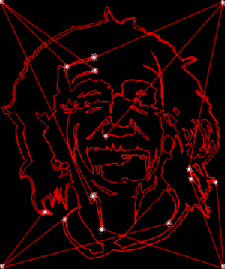Study Guide (go by the chapters assigned by your
instructor)
(Different lecture sections break up the tests differently)
Click here to go to
Class Videos (best way to prepare is to watch the videos)

ALWAYS use the videos if you missed a class AND for Exam reviews
Although the vocabulary is very important, you should
concentrate on the 'Be able to:' sections first!
*****************************************************
ALERT: TOPICS MAY NOT BE IN EXACT ORDER AS IN THE TEXTBOOK. GO BY THE LECTURE/VIDEOS FOR SEQUENCE.
*****************************************************
TEST 6 COVERS MATERIAL STARTING FROM HERE
Chapter 4 (again): Light, and Atoms
(Specifically sections 4.2 - 4.3)
Be able to define:
wavelength
visible light
ultraviolet radiation
infrared ratiation
electromagnetic radiation
speed of light
photon
diffraction
spectrum
temperature
absolute temperature scale
Kelvin scale
thermal radiation
reflected radiation
Wien’s Law
Stephan-Boltzman Law
emission
energy levels
continuous spectra
emission spectra
ground state
excited state
absorption spectra
Be able to:
- list the names of the types of Electromagnetic radiation in order of wavelength (Ch.4)
- the basic components of the atom and describe our modern conception of its structure.
- discuss the nature of electromagnetic radiation, and tell how that
radiation transfers energy and information through interstellar space
- explain how we can determine an object's temperature by observing
the radiation it emits
- explain why do scientists use Kelvin
- explain the differences between thermal radiation and reflected radiation
- state Wien’s Law in connection with the colors of stars
- state Stephan-Boltzman Law and what is means?
- describe the characteristics of continuous, emission, and absorption spectra, and the conditions under which each is produced
- explain how electron transitions within atoms produce unique
emission and absorption spectra
- explain how an electron gets from the ground state to an excited state
Chapter 11: Family of Stars
Be able to define:
stars
light-year
parsec
Hipparchus
apparent magnitude
absolute magnitude
luminosity
classes of stars
H-R diagram
main-sequence stars
giant stars
supergiant start
white dwarf stars
mass-luminosity relation
spectroscopic parallax
main sequence fitting
binary star system
multiple star system
optical double stars
visual binary
spectroscopic binary
eclipsing binary
light curves
Be able to:
- explain how stellar distances are determined.
- explain how angular measurement can be used when distance is NOT known.
- discuss stellar motion and how this motion is measured from Earth.
- explain how physical laws are used to estimate stellar sizes.
- distinguish between stars of various apparent brightness using the Apparent Magnitude Scale.
- distinguish between Luminosity and Absolute Magnitude, and explain how stellar luminosity is determined.
- explain the usefulness of classifying stars according to their colors, surface temperatures, and spectral characteristics.
- describe how an H-R diagram is constructed and used to identify stellar properties.
- explain how stellar masses are measured and how mass is related to other stellar properties.
- explain how spectroscopic parallax is determined
- explain how Main Sequence Fitting is determined
- explain how the formation of a star is affected by its mass.
- describe the Mass-Luminosity relationship on the HR Diagram
Chapter 12: Formation of Stars
Be able to define:
protostar stage
theory of star formation
gravitational contraction
neutrino
protostar
brown dwarf
T Tauri stars
red giant
helium flash
Zero age main sequence stars
HI regions
HII regions
Be able to:
- summarize the composition and physical properties of the interstellar medium.
- describe the characteristics of emission nebulae, and explain their significance in the life cycle of stars.
- discuss the nature of dark interstellar clouds.
- list the steps in the formation of a star like our Sun.
TEST 6 COVERS MATERIAL UP TO THIS POINT
TEST 7 (AND THE FINAL) COVER MATERIAL STARTING FROM HERE (but including everything from Test 6))
Chapter 13-14: Deaths of Stars
Be able to define:
variable star
Cepheid variable
supergiants
planetary nebulae
degenerate matter
Chandrasekhar Limit
supernova
core collapse
supernova remnant
neutron star
pulsars
special theory of relativity
general theory of relativity
black hole
event horizon
accretion disk
nova
type I supernova
type II supernova
Be able to:
- summarize the evolutionary stages followed by a Sun-like star once it leaves the main sequence and describe the resulting remnant.
- explain how white dwarfs in binary-star systems can become explosively active.
- contrast the evolutionary histories of high-mass and low-mass stars.
- describe the two types of supernovae and explain how each is produced.
- explain the origin of elements heavier than helium and discuss the significance of these elements for the study of stellar evolution.
- discuss the observations that help verify the theory of stellar evolution.
- describe the properties of neutron stars and explain how these strange objects are formed.
- explain the nature and origin of pulsars, and account for their characteristic radiation.
- list and explain some of the observable properties of neutron-stars.
- describe how black holes are formed and discuss their effects on matter and radiation in their vicinity.
- relate the phenomena that occur near black holes to the warping of space around them.
- discuss some of the ways in which the presence of a black hole might be detected.

